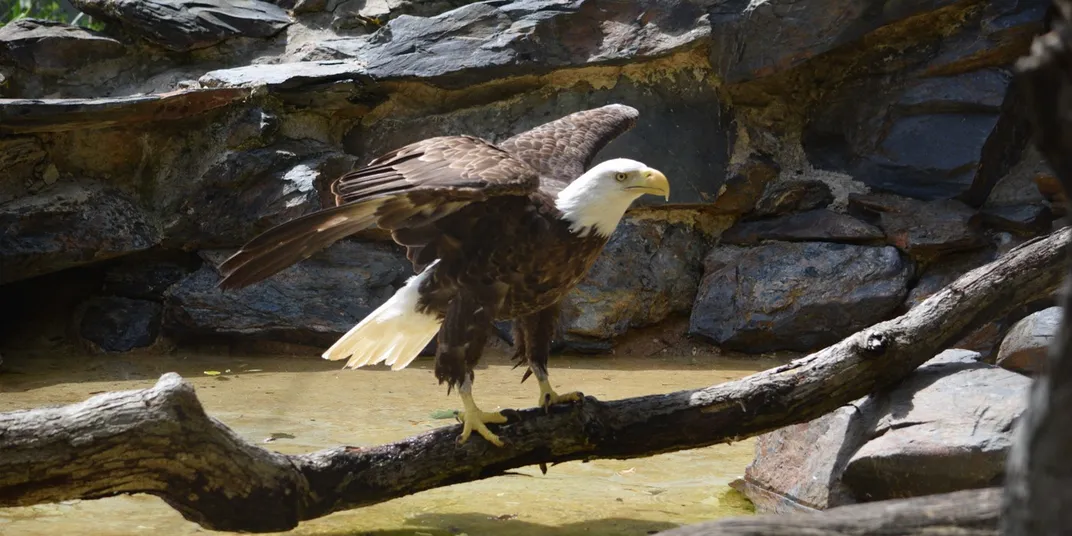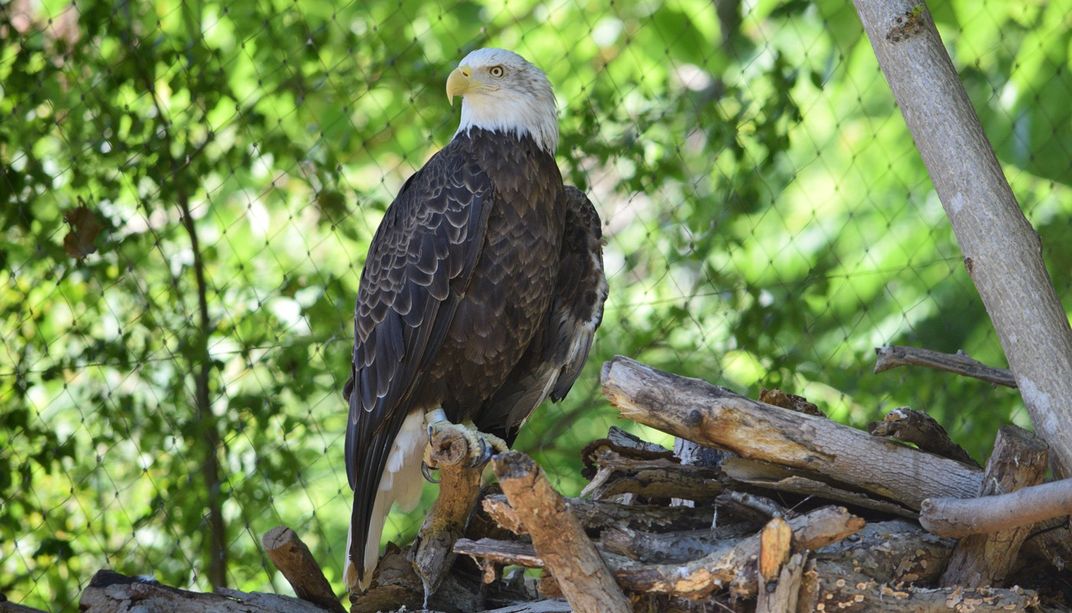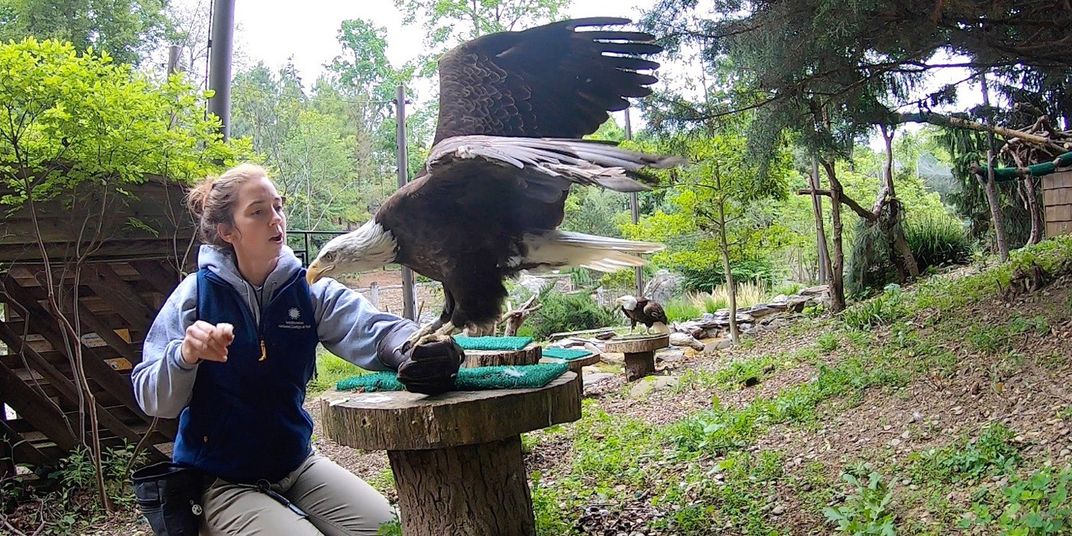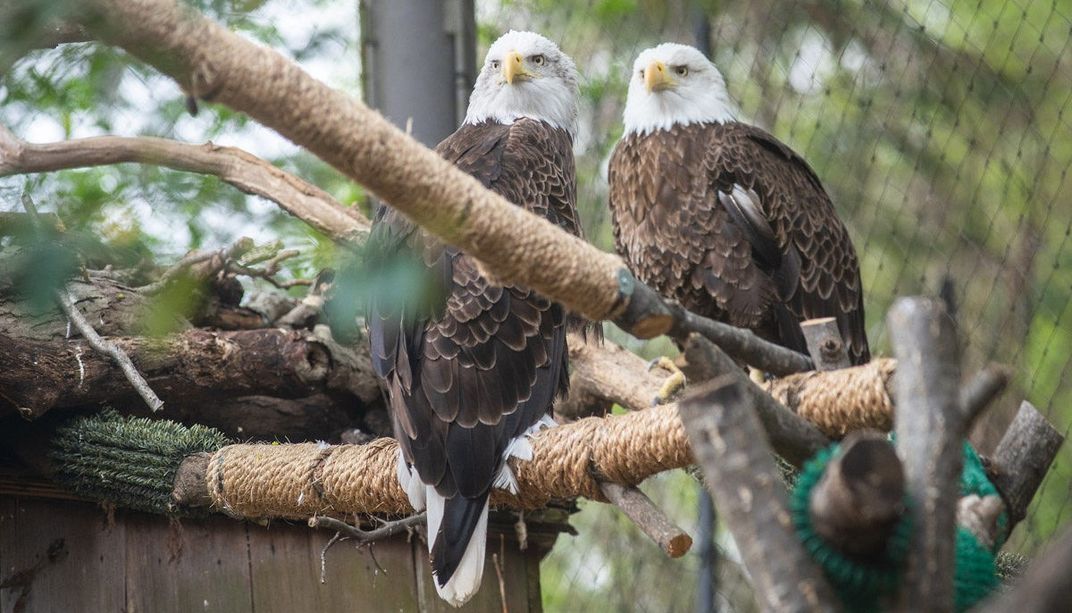NATIONAL ZOO AND CONSERVATION BIOLOGY INSTITUTE
Meet Rescued Bald Eagles Tioga and Annie
Every bald eagle in human care is a rescue
With a 6-foot wingspan, sharp talons and an intimidating stare, bald eagles are majestic birds. Meet Tioga and Annie — both of whom were injured in the wild and rescued — at the Smithsonian’s National Zoo’s American Trail exhibit. Swoop into their care and conservation with animal keeper Ashley Graham.

As a kid I loved animals, but it wasn’t until I worked with birds of prey that I knew they were my passion. Now, bald eagles are my favorite animal. Having the opportunity to train and get up close to them is something I look forward to every day.
Bald eagles are native to the United States. In Washington, D.C., many pairs nest near the Potomac River. Caring for these birds is a unique and rare opportunity, because every bald eagle in human care is a rescue. That includes our female, Annie, who was rescued in Maryland, and our male, Tioga, who was rescued in Pennsylvania. It is illegal to breed and keep these birds otherwise.
Since our bald eagles are rescues, we do not always know their ages. From birth to 5 years old, we can estimate an eagle's age based on its plumage, which is mottled brown with white blotches. Once a bald eagle turns 5, it has its iconic white feathered head, neck and tail. At this point there is no way to estimate its age.
We know Tioga is 23 years old because he was rescued as a fledgling, a young chick who recently left the nest. Annie was rescued as an adult, so we know she was at least 5 years old at the time of her rescue, but she could have been much older. Bald eagles can live 20 to 30 years in the wild and up to 50 years in human care.

Like many of the animals on American Trail, Annie and Tioga’s exhibit is entirely outdoors and mimics what they would experience in the wild. We have a large, tree-like structure in the habitat for the birds to perch and rest on. At the top of this structure is a replica of a nest. Bald eagles return to the same nest year after year. In the wild, their nests are typically between 5 and 6 feet in diameter, and 2-4 feet tall.
If you were to look closely at the perches, you would see Astroturf or rope wrapped around them. In the wild, bald eagles spend a lot of their time in the air. However, both Annie and Tioga have wing injuries and are unable to fly. Their feet are not adapted to continuously hold their weight, so the wrap helps to alleviate some of the pressure on their feet.
The habitat also includes a pool with running water. In the wild, bald eagles live near the water so they can hunt their primary food source: fish. As a form of enrichment, we sometimes give Annie and Tioga live goldfish in their pool or in a black rubber tub. Since they cannot fly, neither of them truly hunt, but they will come down from their perches and exercise their instinct to catch fish.
ABOVE: Annie spent a portion of her life in the wild before she was injured and rescued. She seems to have a strong instinct to hunt moving prey, like goldfish, for enrichment.
Our Department of Nutrition Science provides carcass feedings for the eagles once a month. This gives Tioga and Annie an opportunity to consume prey in its entirety — including skin and bones — which benefits their digestive health. Usually, our eagles receive a whole, fresh salmon (which they seem to really enjoy) or occasionally beef ribs.
The rest of the bald eagles’ diet consists of frozen-thawed rats, quail, chicken and fish. They receive these food items three times a day during husbandry training sessions. We train our animals to voluntarily participate in their own health care. Bald eagles can be challenging to train because it takes time, patience and effort to build their trust and to find a food reinforcement that motivates them.
Over the last few years, our American Trail team has focused on building a relationship with Annie and Tioga. In that time, the eagles have learned a few behaviors that help us monitor their health. When asked, both Annie and Tioga will hop on top of a stump, which allows us to examine them for any injuries or abnormalities. They are also trained to stand still on a scale so we can obtain their weights. At their most recent weigh-in, Annie was 7.5 pounds and Tioga was 6.5 pounds.

When asked, Tioga will step up onto my glove and sit still for a food reward. Right now, he only stays for a few moments, but we are working toward increasing his comfort level so he stays on my glove for longer periods. He is acclimating well to this training. Eventually, I hope to bring him out for a keeper talk so visitors can see him up close.
Animal encounters can help visitors gain a deeper appreciation for and connection to these birds. In the 1960s, only 417 pairs of bald eagles remained in the wild. Thanks to the banning of certain pesticides and the implementation of laws to protect these birds, their populations rebounded. In 2007, they were removed from the Endangered Species List!

We hope that meeting Tioga and Annie at the Zoo — and hearing their stories — will inspire visitors to help protect bald eagles and their native habitats. Since these birds of prey live and rely on water, it is important to keep our lakes and rivers clean. Bald eagles get tangled in fishing line or may use it in their nests, tangling their chicks. Always clean up your trash after a day at the beach or a fishing excursion.
For anyone inspired by these majestic birds, I encourage you to learn more about them. If you hope to one day work with bald eagles, or any animal, get involved as early as you can. Visit local nature centers for opportunities to see animals up close. Then, when you are old enough, volunteer at a zoo!
If you love animals but don’t know which species you want to work with, that’s OK. Pursue opportunities to work with a variety of animals. Gaining hands-on experience will help you progress in the field, and it may open your eyes to new animals that will fast become your favorites.
Planning a visit to the Zoo? Visit Annie and Tioga on American Trail! Has your interest in bald eagles taken flight? Discover more about them in the Zoo’s mobile game, Zoo Guardians! Zoo Guardians is free* to download and play on Apple and Android devices.
*In-app purchases are available.


